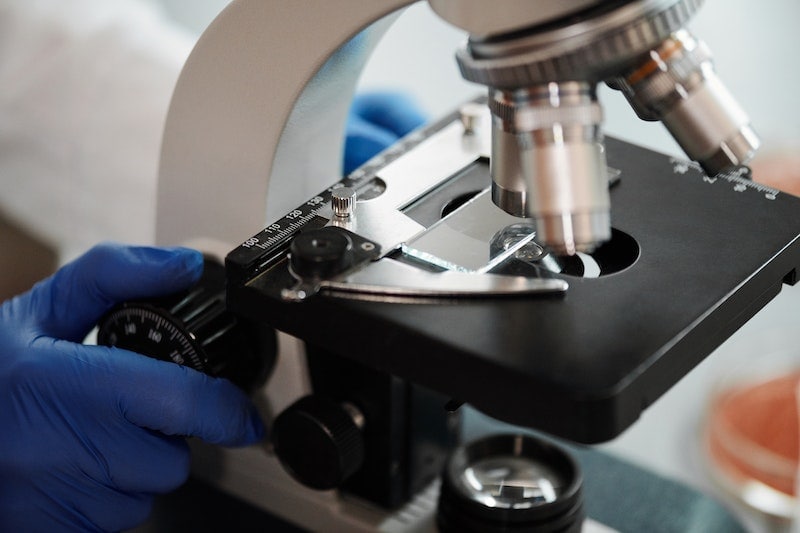How Many Lenses Does a Compound Microscope Have?
Last Updated on

The word “compound” is often used when one is trying to describe something that has more than one element. For example, financial investors normally talk about compounding interest to imply that the interest yielded over time has been calculated after taking into consideration two elements—the principal amount and the simple interest.
In the world of microscopy, there is an optical instrument known as the compound microscope. It’s more advanced in comparison to the simple scope, as it has more than one lens.

Objective Lenses
The multi-element design of these lenses is what makes them the most critical part of the entire optical system. They are like the brains of the operation, as they are responsible for the overall resolution, magnification, image clarity, and image formation. Objective lenses are classified differently, since they usually vary in quality and design. The said classifications are based on:
Microscopy Method
Naturally, you’d expect the microscopy method to determine the type of objective lens used in an examination of a specimen. But it’s the other way round, as the lens influences the method to be applied.
- Phase Contrast Lenses: They are further classified based on the internal phase ring’s neutral density and the build. So, they’ll either fall into the Bright-Medium lenses, Dark-Medium lenses, Apodized Dark-Low lenses, Dark Low-Low lenses, or Dark Low lenses category. Generally, these types of objectives are more useful to users looking to observe unstained, transparent, or colorless specimens.
- Fluorescence Lenses: They are also known as fluorite or semi-apochromatic lenses. These objectives are supposed to ensure the three wavelengths of the light being used to study the specimen have the same refractive indexes.
- Differential Interference Contrast Lenses: These types of lenses are used in techniques that require the introduction of contrast to the images generated, if they have little to no contrast observable while being examined using bright-field microscopy.
- Reflected Darkfield Lenses: Reflected darkfield microscopy is a technique that gives a user the option of observing the diffracting and/or scattering beam from an object/specimen. This is made possible by illuminating the specimen obliquely, using a light source stationed outside the objective lens. They often do so to ensure that no light gets direct access to the observational optical system. The lenses are special in that they have a 360-degree hollow chamber, surrounding a lens element at the center.
Magnification
On the subject of magnification, there are three types of objective lenses: high-power magnification (100X), intermediate (20-50X), and low objectives (5-10X). We also have to note that the magnification power determines whether or not an immersion oil will be applied. If you’re working with a 100X objective lens, you’ll need the oil to achieve a high resolving power. The oil is however not a requirement in the case of the low magnification lens.
Aberration Correction
To avoid confusion, only think about the two levels of corrections whenever you come across the topic of chromatic aberration—the apochromatic and achromatic correction.
Any compound microscope iteration that comes with an achromatic objective lens will be cheaper than that designed with an apochromatic lens. It’s also the most common type of objective, and the simplest in terms of design.
Achromatic lenses are instrumental in the reconciliation of chromatic aberration, in both the blue and red wavelengths.
Is the achromatic objective lens completely effective at dealing with the issue of chromatic aberrations? No, it has its limitations. In addition, it also lacks a flat field of view. The apochromatic lens, on the other hand, has higher precision. To top that off, it’s been chromatically corrected for yellow, blue, and red.

Reflective & Refractive Lenses
Refractive lenses are more popular than their reflective counterparts. If you’ll be examining specimens using the refractive objective, your optical instrument will bend light in a manner that reduces the back reflections that hinder the overall light transmission. This type of lens is well suited for applications that demand a resolution that provides highly fine details.
Reflective lenses have a mirror-based design, meaning they normally observe the basic principles of reflection. Even though these objectives aren’t as common as the refractive lenses, they are not affected by several of the issues that influence the performance of the refractive objectives.
For example, the primary and secondary mirror system that’s part of the reflective lens design permanently eliminates the aberration problem that typically plagues the refractive system. What’s more, they have incredible resolving power and generate a higher light efficiency, which is significant in determining the quality of the image created.
Ocular Lenses (Eyepiece)
The other name of the ocular lens is the eyepiece. The ocular lens is not a feature that’s unique to the compound microscope, as it’s also found on other optical devices. So you shouldn’t be surprised to find one on your pair of binoculars, monoculars, telescopes, etc.
This lens is also a magnifier. It’s tasked with magnifying the specimen’s image that has already been magnified by the objective lenses. Depending on the model of the microscope, you’ll find one to three different lenses, carefully merged to form the ocular lens.
With regards to the magnification aspect, the ocular lens always has a 10X magnification. So, if your objective lens had a magnification of 40X, it will be compounded by the eyepiece lens to give you an image of 400X.
And that’s what distinguishes a compound scope from a simple one. You see, without the ocular lens, you’ll only be able to produce an image that’s 40X. But you have to remember that—unlike the objective lens—a higher magnification, in this case, corresponds to a shorter focal length.
That’s not to say that magnification is the only metric used to measure the performance of this lens. We also always look at the field number, which represents the stretch of the field of view.
The ocular lenses are categorized according to their application and the field stop.
- Huygens Eyepiece: You’ll hear the phrase “negative eyepiece” a lot while using this type of lens. What that means is that the image generated by the objective will lie right behind the field lens, thereby acting as the virtual object for your eye lens. Or let’s put it this way: This ocular lens won’t be useful if you’re trying to directly examine a specimen or the real image generated by its objective. Huygens are ideal for low magnification and come with a field stop that’s inside the lens tube.
- Ramsden Eyepiece: Inside this eyepiece, you’ll find plano-convex lenses. A plano-convex lens is a type of lens that has a flat surface on one side, and a spherical surface on the other. The lenses will be made of the same material and have the same focal length. They are very useful to users looking to correct chromatic aberration. Their field stops are outside the lens tube.
- Periplan Eyepiece: Compound microscopes designed with the periplan eyepiece have several lens elements glued together to allow clear observation by eliminating the chromatic aberration of magnification. With this eyepiece, you’ll be able to see crystal clear images, even if they are positioned at the tail end of the field of view.
- Compensation Eyepiece: Simply put, this type of lens compensates for what’s lost through the aberration effects of the objectives.
- Wide-field Eyepiece: It’s a lens that provides a relatively wider field of view. And it’s more useful when you’re studying living specimens or examining minerals.

Final Thoughts
You can see that we have more than one type of lens installed in a compound microscope. And they are all meant to give users the ultimate user experience. A compound optical instrument is different from a simple microscope, as it has more than one lens. Some sources say it should be having two to three lenses, but some devices have more. All you need to know is that “compound” equals multiple.
Featured Image Credit: Edward Jenner, Pexels
About the Author Robert Sparks
Robert’s obsession with all things optical started early in life, when his optician father would bring home prototypes for Robert to play with. Nowadays, Robert is dedicated to helping others find the right optics for their needs. His hobbies include astronomy, astrophysics, and model building. Originally from Newark, NJ, he resides in Santa Fe, New Mexico, where the nighttime skies are filled with glittering stars.
Related Articles:
How to Clean a Refractor Telescope: Step-by-Step Guide
How to Clean a Telescope Eyepiece: Step-by-Step Guide
How to Clean a Rifle Scope: 8 Expert Tips
Monocular vs Telescope: Differences Explained (With Pictures)
What Is a Monocular Used For? 8 Common Functions
How to Clean a Telescope Mirror: 8 Expert Tips
Brightfield vs Phase Contrast Microscopy: The Differences Explained
SkyCamHD Drone Review: Pros, Cons, FAQ, & Verdict
